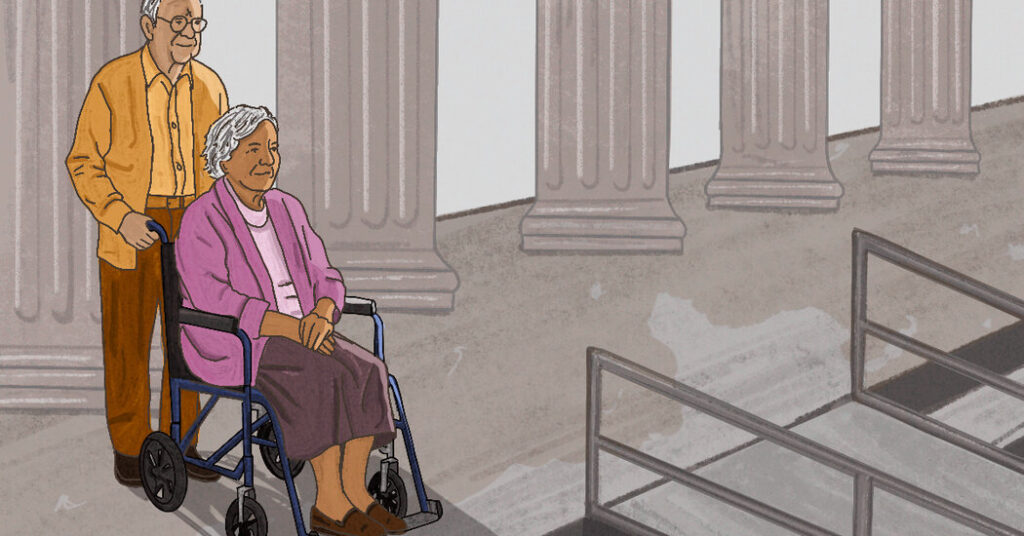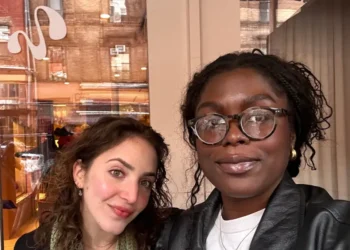In her house in Ypsilanti, Mich., Barbara Meade said, “there are walkers and wheelchairs and oxygen and cannulas all over the place.”
Ms. Meade, 82, has chronic obstructive pulmonary disease, so a portable oxygen tank accompanies her everywhere. Spinal stenosis limits her mobility, necessitating the walkers and wheelchairs and considerable help from her husband, Dennis Meade, who serves as her primary caregiver.
“I know I need hearing aids,” Ms. Meade added. “My hearing is horrible.” She acquired a pair a few years ago but rarely uses them.
Mr. Meade, 86, is more mobile, despite arthritis pain in one knee, but contends with his own hearing problems. Similarly dissatisfied with the hearing aids he once bought, he said, “I just got to the point where I say, ‘Talk louder.’”
But if you ask either of them a question included on a recent University of Michigan survey — “Do you identify as having a disability?” — the Meades answer promptly: No, they don’t.
Disability “means you can’t do things,” Mr. Meade said. “As long as you can work with it and it’s not affecting your life that much, you don’t consider yourself disabled.”
Their daughter Michelle Meade, a rehabilitation psychologist and the director of the Center for Disability Health and Wellness at the university, accompanies her parents to medical appointments and tends to roll her eyes at their reluctance to acknowledge needing support.
Working with other researchers on the recent national poll has shown her how often older adults feel that they are not disabled despite ample evidence to the contrary.
The survey looked at nearly 3,000 Americans aged 50 and older and found that only a minority — fewer than 18 percent of participants over 65 — saw themselves as having a disability.
Yet their responses to the six questions that the Census Bureau’s American Community Survey uses to track disability rates told a different story.
The A.C.S. asks whether respondents have difficulty seeing or hearing, limitations in walking or climbing stairs, difficulty concentrating or remembering, trouble dressing or bathing, difficulty working, or problems leaving the home.
In the university’s survey, about a third of those aged 65 to 74 reported difficulty with one or more of those functions. Among those over 75, the figure was more than 44 percent.
Moreover, when asked about several additional health conditions that would require accommodations under the Americans with Disabilities Act, including respiratory problems or speech disorders, the proportion climbed even higher. Half the 65-to-74 group reported disabilities, as did about two-thirds of those over 75.
Yet only a sliver — fewer than one in five — of older adults had ever received an accommodation from their health care providers to which they are legally entitled under the A.D.A.
Even among the small minority who identified as disabled, only a quarter had asked for an accommodation (though a third received one, whether they asked or not).
“It’s a familiar story,” said Megan Morris, a rehabilitation researcher at N.Y.U. Langone Health and director of the Disability Equity Collaborative. When it comes to the way people describe themselves, “many people still feel like ‘disability’ is a dirty word,” she said.
It’s almost an American value to decline to seek help, even when the law requires that it be available, added Dr. Meade. Faced with a disability, she said, “we’re supposed to toughen up and battle through it.”
That may be particularly true among older Americans whose attitudes formed before the landmark A.D.A. became law in 1990, or even before the 50-year-old Individuals with Disabilities Education Act, which guaranteed access to public education.
“It’s going to be hard for that older generation,” Dr. Morris said. “Disability was something that was locked away. Younger folks are more open to seeing disability as being part of a community.”
In the University of Michigan survey, for instance, among people over 65 who had two or more disabilities, about half identified as a person with a disability. In the younger cohort, aged 50 to 64, it was 68 percent.
Why does that matter? “It greatly assists in health care settings if you disclose a disability and know to request an accommodation and support,” said Anjali Forber-Pratt, the research director at the American Association of Health and Disability.
Such accommodations “can make a stressful situation easier,” she added. They include mammography and X-ray machines that allow patients to remain seated, scales that wheelchair users can roll onto, examination tables that rise and lower so that patients don’t have to step onto a footstool and swivel around.
Health care providers may also offer amplification devices for people with hearing loss, as well as magnifiers and large print materials for the visually impaired. Buildings themselves must be accessible. Practices can send a staff member with a wheelchair to help patients traverse long distances.
Even with a disability parking placard, “you hike in, you wait for the elevator, you hike to the office,” said Emmie Poling, 75, a retired teacher in Menlo Park, Calif.
Because of arthritis and spinal stenosis, “I can’t walk with an upright posture for more than a few minutes” without pain, she said. “I basically live on Tylenol.” Yet when she makes an appointment and the scheduler asks if she will need assistance, Ms. Poling replies that she won’t.
“My personal voice says, ‘Come on, you can do it,’” she said.
Identifying as a person with a disability provides other benefits, advocates say. It can mean avoiding isolation and “being part of a community of people who are good problem-solvers, who figure things out and work in partnership to do things better,” Dr. Meade said.
Government programs and private organizations like the National Disability Rights Network, the Americans with Disabilities Act National Network and the National Association of Councils on Developmental Disabilities help connect people with services and supports in their communities.
Several studies have found, too, that patients who identify as disabled have less depression and anxiety, higher self-esteem and a greater sense of “self-efficacy” than disabled people who don’t.
For years, despite a lifetime of surgeries for congenitally dislocated hips, as well as joint replacements and cancer treatment, Glenna Mills, an artist in Oakland, Calif., told herself that she was not disabled.
“I suffered a lot by denying that I couldn’t walk very far,” she recalled. Although walking caused pain in her knees, hips and shoulders, “I didn’t want people to see me as someone who couldn’t keep up,” she added.
But about 10 years ago, “I stopped worrying about that,” said Ms. Mills, 82. “I was more willing to say, ‘I can’t do that activity. I can’t walk that far.’” She bought a scooter that allowed her to take walks with her husband and dog, and to spend time in museums. “I’m happier now,” she said.
More often, older Americans resist a label that could help improve their care. Even those who do request accommodations may find that enforcement of the A.D.A. remains spotty, in part because patients don’t always report violations.
The Meades, after years of pleading from their children, have made appointments to see an audiologist about new hearing aids.
But Ms. Poling intends to struggle on without seeking or accepting assistance. “I know that point will come,” she said. “I’ll attempt to surrender as gracefully as possible, given my personality.”
Until then, she said, “the mental picture that’s acceptable to me is not wanting to look like I’m disabled.”
The New Old Age is produced through a partnership with KFF Health News.
The post Wheelchair? Hearing Aids? Yes. ‘Disabled’? No Way. appeared first on New York Times.




